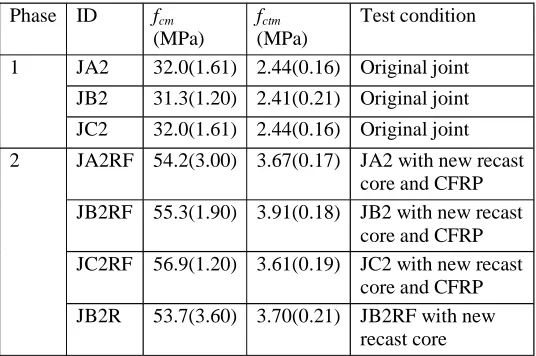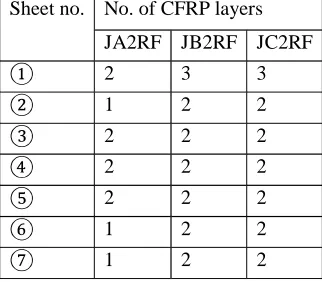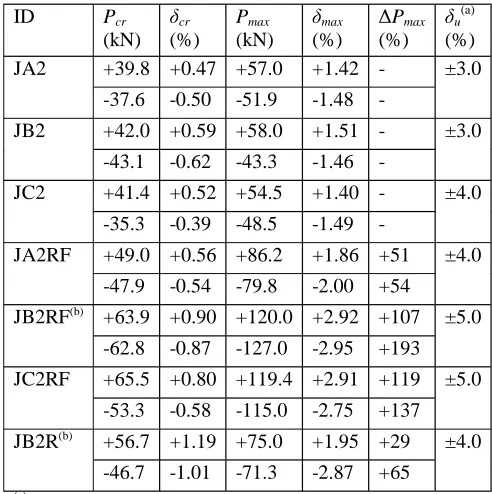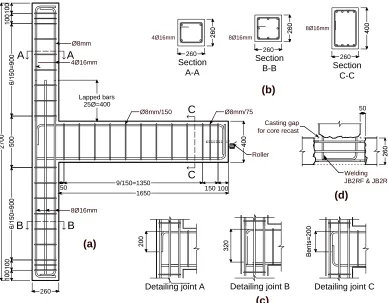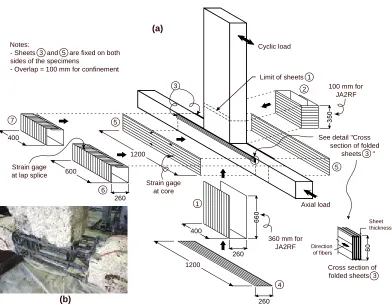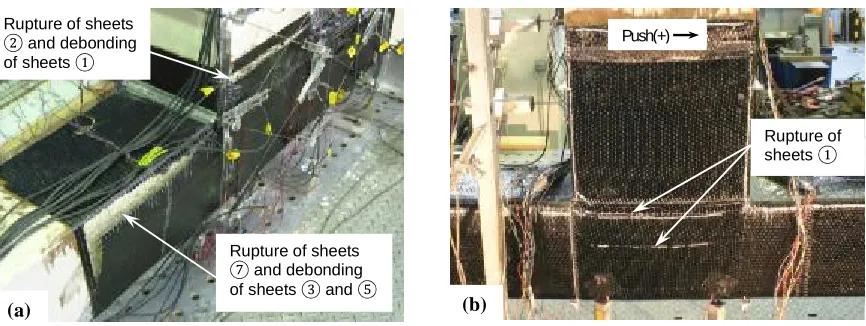promoting access to White Rose research papers
White Rose Research Online eprints@whiterose.ac.uk
Universities of Leeds, Sheffield and York
http://eprints.whiterose.ac.uk/
This is an author produced version of a paper published in Journal of
Composites for Construction.
White Rose Research Online URL for this paper: http://eprints.whiterose.ac.uk/78009
Published paper
Garcia, R., Jemaa, Y., Helal, Y., Guadagnini, M. and Pilakoutas, K. (2013)
Seismic strengthening of severely damaged beam-column RC joints using CFRP.
Seismic strengthening of severely damaged beam-column RC
1joints using CFRP
2Reyes Garcia, S.M.ASCE1*, Yaser Jemaa2, Yasser Helal3, Maurizio Guadagnini4, Kypros Pilakoutas5 3
Abstract
4
This paper investigates the seismic behavior of three full-scale exterior reinforced concrete (RC) beam-5
column joints rehabilitated and strengthened with externally bonded Carbon Fiber Polymers (CFRP). The 6
specimens had inadequate detailing in the core zone and replicated joints of a real substandard building tested 7
as part of the EU-funded project BANDIT. Seven tests were performed in two successive phases. The bare 8
joints were first subjected to reversed cyclic loading tests to assess their basic seismic performance. As these 9
initial tests produced severe damage in the core, the damaged concrete was replaced with new high-strength 10
concrete. The specimens were subsequently strengthened with CFRP sheets and the cyclic tests were 11
repeated. The results indicate that the core replacement with new concrete enhanced the shear strength of the 12
substandard joints by up to 44% over the bare counterparts. ASCE/SEI 41-06 guidelines predict accurately 13
the shear strength of the bare and rehabilitated joints. The CFRP strengthening enhanced further the joint 14
strength by up to 69%, achieving a shear strength comparable to that of joints designed according to modern 15
seismic provisions. Therefore, the rehabilitation/strengthening method is very effective for post-earthquake 16
strengthening of typical substandard structures of developing countries. 17
Subject headings: Full-scale tests; Reinforced concrete; Joints; Rehabilitation; Strengthening; Fiber reinforced
18
polymer; Composite materials; Shear strength
19
Keywords: beam-column RC joints; seismic strengthening; concrete rehabilitation; externally bonded CFRP
20
1
PhD. Dept. of Civil and Structural Engineering, The University of Sheffield, Sir Frederick Mappin Building, Mappin Street, Sheffield, S1 3JD, UK. Email (corresponding author*): r.garcia@sheffield.ac.uk.
2 PhD. Dept. of Civil and Structural Engineering, The University of Sheffield, Sir Frederick Mappin Building, Mappin Street,
Sheffield, S1 3JD, UK.
3
PhD. Dept. of Civil and Structural Engineering, The University of Sheffield, Sir Frederick Mappin Building, Mappin Street, Sheffield, S1 3JD, UK.
4Senior lecturer. Dept. of Civil and Structural Engineering, The University of Sheffield, Sir Frederick Mappin Building, Mappin
Street, Sheffield, S1 3JD, UK.
5
Introduction
21
Recent strong earthquakes in developing countries (Kashmir, 2005; China, 2008; Indonesia, 2009 and Haiti, 22
2010) caused extensive economic and human losses due to the poor behavior of many old reinforced concrete 23
(RC) buildings. Many structural failures in these structures can be attributed to the lack of internal steel 24
stirrups in beam-column joints, which increase the seismic vulnerability of the building. The local 25
strengthening of these deficient elements is a feasible option for reducing the vulnerability of such 26
substandard buildings. Over the last twenty years, externally bonded Fiber Reinforced Polymers (FRP) have 27
been used extensively to strengthen seismically deficient elements. In comparison to other strengthening 28
materials, FRP possess advantages such as high resistance to corrosion, excellent durability, high strength to 29
weight ratio, adaptability to different shapes, and ease and speed of in-situ application (Gdoutos et al. 2000). 30
Numerous experimental studies have demonstrated the effectiveness of FRP strengthening at improving the 31
seismic behavior of substandard RC beam-column joints (e.g. Mosallam 2000; Gergely et al. 2000; Granata 32
and Parvin 2001; El-Amoury and Ghobarah 2002; Antonopoulos and Triantafillou 2003; Prota 2004; Said 33
and Nehdi 2004; Ghobarah and El-Amoury 2005; Mukherjee and Joshi 2005; Engindeniz 2008; Pantelides 34
2008; Akguzel and Pampanin 2010; Alsayed et al. 2010; Le-Trung et al. 2010; Bousselham, 2010; Parvin et 35
al. 2010; Al-Salloum 2011a; 2011b; Ilki et al. 2011). Most of these studies aimed at a) assessing the 36
effectiveness of FRP at preventing premature shear failure of joints without internal confinement, and b) 37
changing the strength hierarchy of the joints to promote yielding in the beam reinforcement. Despite the 38
extensive research, the majority of these studies focused on undamaged specimens, whilst less research has 39
investigated the use of FRP as a post-earthquake strengthening solution in joints that experienced severe 40
damage. Different rehabilitation techniques have been used to repair damaged joints, including a) crack 41
injection with epoxy resin and partial core replacement with high-strength cement paste or mortar 42
(Karayannis et al. 1998; Karayannis and Sirkelis 2008; Sasmal et al. 2011), b) complete core replacement 43
with new concrete (Ghobarah and Said 2001; 2002), and c) partial core replacement with high-strength 44
mortar (Tsonos 2008; Sezen 2012). However, researchers rarely attempted to evaluate the individual 45
by Karayannis et al. (1998), the use of high-strength materials in the rehabilitation can by itself enhance the 47
strength of the joint considerably. Crack injection and mortar repairing have proven effective at low to 48
moderate levels of damage, but they may be less effective when severe damage occurs (e.g. complete 49
concrete crushing in the core) or bond between reinforcing bars and concrete is lost. In this case, the complete 50
replacement of the core with new concrete may be necessary to recover its structural integrity before applying 51
the FRP. Nonetheless, results of joints rehabilitated and strengthened with this solution are not available in 52
the literature. A combination of core replacement with high-strength concrete and FRP strengthening can be 53
suitable for rehabilitating existing substandard buildings in developing countries, where strengthening 54
interventions are usually carried out in structures damaged after an earthquake. 55
This study is part of the multistage EU-funded project BANDIT (SERIES Program FP7) which focuses on 56
the seismic strengthening of substandard RC structures typical of developing countries. The work carried out 57
under this project comprises tests on beam-column joints and shake table tests on a full-scale RC building 58
(Garcia 2013; Garcia et al. 2014a). This paper focuses on the former tests and investigates the seismic 59
behavior of severely damaged full-scale RC beam-column joints rehabilitated and strengthened with 60
externally bonded CFRP. The geometry and detailing of the tested specimens were similar to those used in 61
the joints of the BANDIT building (Garcia et al. 2014a). Therefore, the current tests aimed at i) assessing the 62
capacity and behavior of substandard joints under severe demands, and ii) investigating effective 63
rehabilitation and strengthening solutions for damaged joints with FRP sheets. The experimental results are 64
discussed and compared to predictions obtained according to existing models. 65
Experimental program
66
Three RC beam-column joints were tested in two successive phases. In phase 1, the bare joints were 67
subjected to cyclic tests up to drifts of about 4.0%, and the tests were halted when the peak capacity dropped 68
by 50%. As these tests produced severe damage in the joint core, the damaged concrete was fully removed 69
and replaced with new high-strength concrete. The specimens were subsequently strengthened with externally 70
Geometry of specimens 72
The specimens simulated a full-scale 2D exterior joint between contra-flexure points of a floor in a multi-73
story moment-resisting frame, but excluding the slabs (see Fig. 1(a)). The column had a cross section of 74
260×260 mm and a height of 2700 mm. The longitudinal column reinforcement consisted of 16 mm bars (see 75
Fig. 1(b)). These bars were lapped over a length lb=25db (db= bar diameter) just above the joint core to
76
represent typical construction practices of developing countries. 77
The beam had a cross section of 260×400 mm and a length of 1650 mm. The main flexural reinforcement 78
consisted of 16 mm bars as shown in Fig. 1(b). Three types of anchorage detailing were examined for the top 79
beam reinforcement as shown in Fig. 1(c). To study the effect of deficient bar anchorage, the bottom beam 80
reinforcement of detailing types A and B was anchored into the joint for a length of 220 mm only 81
(approximately 14db), with no hooks or bends. This short anchorage length would be deemed insufficient to
82
develop the full capacity of the 16 mm bars according to current design recommendations. The column-to-83
beam relative flexural s MRcol MRbeam) of the specimens was approximately 1.0, and therefore
84
the strong column-weak beam strength hierarchy intended by current design philosophy was not satisfied. 85
Moreover, the specimens were designed to fail at the core where no confining stirrups were provided. To 86
prevent a shear failure outside the joint core, the column and beam were reinforced with 8 mm transverse 87
stirrups spaced at 150 mm centers. The stirrups were closed with 90°hooks instead of 135°hooks typically 88
required by current seismic codes. 89
Table 1 gives some of the main characteristics of the beam-column joints including concrete strength. The 90
specimens are identified using an ID code in which the first letter stands for “Joint” and the second for the 91
type of beam reinforcement detailing (A, B or C), respectively. The letters after the number indicates the 92
condition of the joints during the test: “R” stands for a joint tested in rehabilitated condition (i.e., with a new 93
concrete core), whilst “RF” stands for a joint tested in rehabilitated condition and strengthened with FRP 94
sheets. The core of joint JB2RF was recast again and the specimen (renamed as JB2R) was retested to 95
Material properties 97
The joints were cast using two batches of ready mixed concrete. A steel roller was inserted at the center of the 98
cross section of the beam tip during casting, as shown in Fig. 1(a). Following casting, the specimens were 99
cured for seven days in the formwork and then stored under standard laboratory conditions. The mean 100
concrete compressive strength (fcm) was determined from tests on three 150×300 mm concrete cylinders
101
according to BS EN 12390-3 (BSI 2009a). The indirect tensile splitting strength (fctm) was obtained from tests
102
on three 100×200 mm cylinders according to BS EN 12390-6 (BSI 2009b). All cylinders were cast at the 103
same time and cured together with the joints. Table 1 summarizes the mean values and standard deviations 104
obtained from the tests. 105
Grade S500 ribbed bars were used as reinforcement for all joints. The yield and tensile strengths of the steel 106
reinforcement were obtained from three test samples and were found to be fy=612 MPa and fu=726 MPa for
107
the 8 mm bar, and fy=551 MPa and fu=683 MPa for the 16 mm bar, respectively. The elastic modulus of both
108
bars was determined asEs=209 GPa.
109
After phase 1 of testing, the damaged concrete in the core of the joints was completely removed and replaced 110
with new highly flowable concrete. In joint JB2, the bottom bars of the beam were welded to the 90° bends of 111
the top beam reinforcement as shown in Fig. 1(d) (JB2RF and JB2R in phase 2). Before casting the new 112
concrete, the contact surfaces of the existing concrete were thoroughly cleaned with compressed air and 113
moistened for 24 hours. No bonding agent was used between the new and existing concrete. At the end of 114
casting, the new core was cured in the mold for three days, and without the mold for four additional days. 115
Following the core replacement, the joints were strengthened with externally bonded CFRP using a wet lay-116
up procedure. The unidirectional CFRP sheets had the following nominal properties provided by the 117
manufacturer: tensile strength ff=4140 MPa, elastic modulus Ef=241 GPa, ultimate elongation fu=1.70%, and
118
sheet thickness tf=0.185 mm. Before bonding the CFRP sheets, the concrete surfaces were wire brushed and
119
cleaned with pressurized air to improve adherence, and the corners were rounded off to a radius of 120
Experimental setup and instrumentation 122
The joints were tested with the column in horizontal position as shown in Fig. 2. A guiding device consisting 123
of an oiled roller inserted between two parallel steel plates was used at the beam tip to restrain possible out-124
of-plane movement at large displacements, but such device allowed free displacement and rotation of the 125
beam in the direction of testing. Displacements were monitored using Linear Variable Differential 126
Transformers (LVDTs) at the locations shown in Fig. 2. Deformations of the joint core were also measured 127
using a set of 16 linear potentiometers. The strain developed along the beam and column steel reinforcement 128
and CFRP sheets was monitored using strategically placed foil-type electrical resistance strain gages (see Fig. 129
3(a)). 130
The cyclic load was applied to the beam in displacement control using a servo-hydraulic actuator (see Fig. 2). 131
Three push-pull cycles were applied at drift ratios ( =beam tip displacement/beam length) of ±0.25%, 132
±0.5%, ±0.75%, ±1.0%, ±1.5%, ±2.0%, ±3.0%, ±4.0% and ±5.0%. Cycles at ±0.75% and ±1.5% were not 133
applied in phase 2 to reduce the testing time. Each cycle was applied in the push (+) direction first, which 134
tensioned the top beam reinforcement. A second actuator applied a constant axial load N=150 kN on the 135
column (see Fig. 2), which corresponds to an approximate axial load ratiov=N/(fcmAg)=0.07, where Agis the
136
column gross cross sectional area. The formation and development of cracks were monitored continuously 137
during the test. Moreover, the tests were paused at the onset of the first visible diagonal core cracking (which 138
appeared suddenly) to record the applied load and tip displacement. The tests were halted when the load 139
capacity of the joints dropped to approximately 50% of the peak load. 140
CFRP strengthening 141
Fig. 3(a) shows a general view of the CFRP strengthening sequence. The main goal of the strengthening was 142
to develop the plastic capacity of the beam reinforcement. To achieve this, the premature failure of the core 143
zone had to be prevented and the flexural capacity of the column enhanced. 144
Strengtheningofjointcore 145
The CFRP strengthening was designed considering the total shear capacity of the joint core as the sum of 146
06 (2007) using Eq. (1), a shear strength coefficient =0.083×6 psi=0.50 MPa and the strength of the new 148
concrete core (see Table 1). 149 kN 250 55 ) 260 )( 260 )( 5 . 0 ( c j c A f
V (1)
where Ajis the effective horizontal joint area.
150
The theoretical shear force required to develop the plastic capacity of the beam reinforcement Vjh(associated
151
to a beam loadPy=±106 kN) was computed using force equilibrium according to Eq. (2).
152 kN 392 2400 ) 260 ( 5 . 0 1370 ) 362 ( 875 . 0 1370 106000 5 . 0 c c b b col b jh H h L z L P V T V (2)
where Tbis the tension force of the top beam reinforcement; Vcolis the column shear; Lbis the beam length to
153
the applied load point; Hc is the distance between column supports; hc is the height of the column cross
154
section; and z is the lever arm of the beam flexural moment (assumed equal to 0.875 the beam effective 155
depth). 156
Thus, the shear to be resisted by the CFRP sheets is Vf=392-250=142 kN. The required number of CFRP
157
layers was determined using ACI 440.2R-08 guidelines (ACI Committee 440 2008) adopting the 158
recommended value of effective CFRP strain ( fe=0.004) and =90°:
159 layers 2 layers 6 . 1 ) 222 )( 241000 )( 004 . 0 )( 185 . 0 ( 2 142000 2f fe f fv
f d E t V n (3)
where dfvis the effective depth of FRP shear reinforcement.
160
Accordingly, a minimum of two layers of CFRP were required to strengthen the joint core. As shown in Fig. 161
3(a), U-shaped CFRP sheets strengthened the joint core to increase its shear strength (layer ). Confining 162
sheets (layer ) were then wrapped around the beam to prevent premature debonding of the U-shaped 163
Strengtheningofcolumn 165
The flexural capacity of the column was increased by bonding CFRP sheets parallel to the column axis 166
(layers and in Fig. 3(a)). The number of layers required to satisfy a hierarchy strength 167
MRcol MRbeam was determined using conventional moment-curvature analysis assuming perfect bond
168
between CFRP sheets and concrete. The presence of the beam hindered the continuity of sheets on the 169
inner part of the column. To avoid interrupting or mechanically anchoring sheets in the beam section, 170
these sheets were folded and bonded on the column faces. As a result, sheets provided slightly lower 171
flexural strength in comparison to sheets . Nonetheless, detailed moment-curvature analyses indicate that 172
such difference is less than 10%, which is acceptable for practical strengthening applications. An additional 173
layer of CFRP ( ) was bonded on both sides of the column to keep sheets in place during the subsequent 174
installation of the confining sheets. Finally, sheets and were used to increase the ductility of the 175
column and to avoid premature debonding of , and . 176
Table 2 summarizes the number of CFRP sheets used for each joint. In joint JA2RF, sheets had a shorter 177
bonded length to examine its effect on the resulting confinement level of the joint core and overall joint 178
behavior. As shown later, the relatively low capacity of joint JA2RF showed that two layers of CFRP sheets 179
were insufficient to develop the plastic capacity of the beam reinforcement. Therefore, three CFRP layers 180
were used for joints JB2RF and JC2RF (Table 2). Also, two layers of confining sheets were
181
used in the latter joints as one layer did not prevent premature fiber debonding at beam and column corners of 182
joint JA2RF. No mechanical anchors or steel plates were utilized to prevent debonding of CFRP sheets. 183
After the tests on joint JB2RF, the CFRP sheets were completely removed and the core was replaced again 184
following the same procedure described previously (see Fig. 3(b)). Post-tensioned steel strapping was applied 185
to the beam and column outside the core to promote the development of shear cracks in the core, and the joint 186
was retested (JB2R). 187
It should be noted that in actual rehabilitation of damaged buildings, the removal and recast of the concrete 188
core sets, thus allowing the preparation of concrete surfaces for the application of CFRP sheets. In real CFRP 190
strengthening applications adopting the layout shown in Fig. 3(a), sheets could be bonded (completely 191
unfolded) on the inner face of the column, and then secured using mechanical CFRP anchors embedded in the 192
concrete. Such anchoring solution was proven effective at preventing debonding of the CFRP strengthening 193
on a substandard full-scale RC building tested by the authors (Garcia et al. 2010). 194
Test results and discussion
195
Table 3 reports a) the load and drift ratio at the onset of diagonal cracking in the core (Pcr and cr,
196
respectively), b) the load and drift ratio at peak load (Pmax and max, respectively), c) enhancement in peak
197
Pmax) over the bare specimens, and d) ultimate drift ratio ( u) causing a 50% drop inPmax. The results
198
are presented for the push (+) and pull (-) directions. The following sections summarize the most significant 199
observations of the testing program and discuss the results shown in Table 3. 200
Bare and rehabilitated joints 201
The progression of damage and final failure mode of the bare and rehabilitated joints were very similar. 202
Despite the short anchorage length of the bottom beam reinforcement, pull out failure was not observed. This 203
was confirmed by experimental observations (no cracks formed at the beam-joint interface) and by 204
comparison of readings from strain gages fixed on the bars with displacements. Narrow splitting cracks 205
formed along the spliced reinforcement in the column. As shown in Fig. 4(a) and (b), final failure of the bare 206
and rehabilitated specimens was dominated by extensive diagonal cracking and partial concrete spalling in 207
the core zone (J-type failure). 208
The load-drift responses of the bare joints (Fig. 5(a)-(c)) show that the specimens remained elastic until the 209
onset of diagonal core cracking, when the load dropped slightly. Despite the lack of steel stirrups, the bare 210
specimens failed gradually and sustained drifts of up to ±4.0% (JC2 in Table 3). Such gradual failure is 211
attributed to progressive crushing of the diagonal concrete strut in the joint core. As shown in Table 3, the 212
load and drift at the onset of diagonal cracking were similar for all bare joints, regardless of the type of 213
detailing in the beam reinforcement. The peak load for all bare joints was achieved at very similar max
1.5% in both the push and pull directions and no pullout failure occurred during the tests because shear 215
failure dominated the response. The lower loads resisted in the pull direction (Table 3) can be due to damage 216
produced by the cyclic loading regime. The influence of the different anchorage solutions used for the joints 217
was examined in another study (Jemaa 2013). 218
The load-drift relationship of joint JB2R in Fig. 5(d) shows the effect of core replacement on the shear 219
strength of the joint (see also Table 3). Compared to JB2, the rehabilitation enhanced the peak capacity of 220
joint JB2R by an average of 44%. This confirms that, in spite of severe damage produced in the joints during 221
testing phases 1 and 2, the high-strength concrete used in the core recast and the welding of the top and 222
bottom beam reinforcement (JB2R only) enhanced considerably the joint capacity. Note that although the 223
beam reinforcement did not pullout during the tests, such bars were welded in JB2R to correct excessive 224
permanent deformations and to assess the effectiveness of this strengthening solution as pullout failure was 225
not desired. This approach was also adopted in the joints of a full-scale building tested recently by the authors 226
(Garcia et al. 2014a). 227
Whilst in this study the joint specimens were tested up to a drift level of ±4.0% to produce severe damage and 228
help understand their vulnerability, it is evident that the residual value and capacity of an actual substandard 229
building pushed to such drift value would be relatively low. Nonetheless, concrete core replacement can be 230
carried out at lower levels of drift or damage and is justified when, for instance, the building experience 231
extensive shear damage or was cast with low-strength concrete (fcm<20 MPa). Poor quality concrete is a
232
common deficiency of many low-rise substandard constructions of developing countries. 233
CFRP-strengthened joints 234
As the CFRP sheets were bonded directly onto the concrete surface, the onset of diagonal cracking in the 235
joint core could not be observed. No damage was observed in the CFRP sheets, but extensive “crackling” 236
noise at a drift ratio ±1.0% indicated that debonding was taking place at different locations. In specimen 237
JA2RF, full debonding of sheets and the rupture of sheets at of ±3.0% led to premature failure of the 238
) at ±5.0% and ±4.0% in joints JB2RF and JC2RF, respectively. Although no mechanical anchors were 240
used, sheet debonding did not occur in these joints. Fig. 6(a) and (b) show specimens JA2RF and JB2RF at 241
the end of the tests. The removal of the CFRP sheets after the tests revealed extensive diagonal cracking in 242
the core, but the width and extension of cracks reduced considerably in comparison to the bare specimens. No 243
evident damage was observed in the lap splices or in the columns outside the CFRP-strengthened area. 244
However, the beams of joints JB2RF and JC2RF experienced significant flexural cracking outside the CFRP-245
strengthened region. 246
Fig. 7(a) to (c) show the load-drift relationships for the CFRP-strengthened specimens. The combination of 247
core replacement and CFRP strengthening enhanced significantly the load and deformation capacity of the 248
joints. Compared to the bare counterparts, the peak load of specimens JA2RF, JB2RF and JC2RF increased 249
by an average of 52%, 145% and 128%, respectively (see Table 3). Moreover, the peak and ultimate drift 250
ratios of the joints also increased by up to 97% and 67%, respectively (joint JB2RF). Fig. 7(a) to (c) show 251
that the area enclosed by the hysteretic loops is significantly larger for the CFRP-strengthened joints than for 252
the bare specimens, which implies that these joint had a higher energy dissipation capacity. 253
Fig. 8 shows envelopes of the load-drift ratio relationships of the tested joints. The results indicate that the 254
bare specimens resisted only 40-55% of the load required to develop the plastic capacity of the beam,Py(see
255
also Table 3). The peak load of specimen JA2RF reached 78% of Pyas premature debonding of the CFRP
256
sheets occurred. In contrast, specimens JB2RF and JC2RF developed some yielding in the top and bottom 257
beam reinforcement as shown by short post-yield incursions in Fig. 8. Readings from strain gages also 258
confirmed that the beam reinforcement of the joints developed strains of up to 4000-5000 (e.g. Fig. 9). As 259
a result, joints JB2RF and JC2RF failed in a more ductile BJ-type mode (i.e. joint failure after yielding of 260
beam reinforcement), thus achieving the strengthening goals. However, CFRP rupture and excessive damage 261
Stiffness degradation and shear stress-strain response 263
Fig. 10 compares the stiffness degradation of the tested specimens. The secant stiffness is defined by the 264
slope of a line connecting the maximum drifts in the push and pull directions of the first hysteresis loop. The 265
results indicate that the core recast was very effective at restoring the original stiffness of the CFRP-266
strengthened specimens. The stiffness of JB2R was not fully recovered and this can be attributed to the 267
flexural cracks formed in the beam of this joint during the previous tests (JB2 and JB2RF, see Fig. 10). In 268
comparison to the bare specimens, it is also evident that the CFRP strengthening of the joints reduced 269
significantly the rate of stiffness degradation. The fast stiffness deterioration after ±2.0% in the CFRP-270
strengthened specimens can be attributed to the onset of CFRP rupture and to damage in the core. 271
Fig. 11 compares the experimental shear stress-strain response of joints JC2 and JC2RF, which are 272
representative of the rest of the specimens. Shear strains were derived using average measurements of the 273
linear potentiometers located at the joint core. Results in Fig. 11 are only shown up to the point where the 274
potentiometers failed, after reaching the joint capacity. It is shown that average joint strains at peak load 275
(Pmax) of specimens JC2 and JC2RF were 0.0067 and 0.069 rad, respectively, whereas maximum joint strains
276
were 0.025 and 0.11 rad. The considerable enhancement in joint deformation capacity of joint JC2RF is 277
attributed to the rehabilitation/strengthening intervention. Due to space limitations, the detailed analysis of 278
the joint strains will be published by the authors in a future paper. 279
CFRP strains 280
Typical strain readings (see Fig. 12(a)) from gages located at the core zone of the specimens indicate that, as 281
expected, CFRP strains were negligible at the beginning of the test and increased after the onset of diagonal 282
core cracking. In general, the CFRP strain values measured at peak load (Pmax) varied from 2500 (joint
283
JA2RF) to 7300 (JB2RF), and at ultimate drift ( u) varied from 11900 (JA2RF) to 16900 (JB2RF).
284
The latter values correspond to 70% and 100% of the ultimate strain of the CFRP sheets, respectively. Fig. 285
12(b) shows typical strain readings from gages fixed on the confining sheets at the mid-point of the lap 286
splice length (see Fig. 3(a)). Overall, maximum strains at Pmax varied from 200 to 570 only, whereas
287
strains at uwere always lower than 1000 . These results confirm previous research by the authors (Garcia
et al. 2013; 2014b) that showed that low CFRP strains ( f<1600 ) develop in CFRP-confined lap-spliced
289
RC members dominated by bond splitting failure. 290
Contribution of rehabilitation and CFRP to total joint shear strength 291
The maximum capacities of the strengthened joints reported in Table 3 include the contributions of the 292
replaced core and the CFRP strengthening. To decouple the individual contribution of the replaced core, the 293
shear strength factor included in current guidelines (e.g. ACI-ASCE Committee 352 2002) is adopted in this 294
study. Table 4 summarizes the experimental shear stress jh (computed using Eq. (4)) and corresponding
295
factor for the tested joints. The reported values are the average of the push and pull directions. 296
j jh
jh V A (4)
For comparison, Table 4 also shows the factors ( = jh/ fc) computed using existing predictive models: P
297
Priestley (1997); KLKim and LaFave (2009); HJHassan (2011) for J-type failure; HSHassan (2011) for
S-298
type failure due to the pullout of the straight bottom beam reinforcement; and PMPark and Mosalam (2012).
299
A “virtual” joint index of 0.0139 was adopted to determine KLfor joints without shear reinforcement a as
300
suggested by Kim and LaFave (2009). Table 4 also includes the shear strength factor A41for exterior joints
301
given by the ASCE/SEI 41-06 (2007) guidelines. 302
Table 4 shows that the bare specimens have similar shear strength factors ranging from 0.49 to 0.52. 303
Moreover, despite the damage produced during testing phases 1 and 2, specimen JB2R had a similar factor 304
=0.53. This indicates that the replaced core resisted a shear stress comparable to that of the bare joints. It is 305
shown that the approaches proposed by Priestley, Kim and LaFave, Hassan for J-type failure and Park and 306
Mosalam overestimate the experimental shear strength factors by an average of 13%, 77%, 48% and 85%, 307
respectively. Conversely, Hassan’s S-failure model always underestimates by an average of 44%. This 308
underestimation may be due to the calibration of the model, which was done using joints with short 309
anchorage lengths of 152 mm only. Whilst recent research (e.g. Park and Mosalam 2013) suggests that ASCE 310
values of the bare and rehabilitated joints tested in this research. Consequently, ASCE 41 is used in this 312
study to evaluate the shear strength of the recast cores. 313
Table 4 also shows the decoupled contributions of the recast core and CFRP strengthening for the CFRP-314
strengthened specimens. In this table, jh,coreand jh,CFRPare the shear stress contributions of the recast core
315
and CFRP strengthening to the total jh,core jh,CFRP are the
316
corresponding shear stress enhancements. For specimen JB2RF, jh,core was taken as the shear stress of the
317
corresponding rehabilitated specimen JB2R. For joints JA2RF and JC2RF, jh,core was computed adopting
318
=0.50 MPa and the concrete strength of the replaced core listed in Table 1. The value jh,CFRP was then
319
calculated as the difference between the experimental shear stress jh of the CFRP-strengthened joints and
320
jh,core. The rehabilitation and strengthening were very effective at increasing the shear strength of the joints,
321
with the new core contributing by up to 44% of the total and the externally bonded CFRP by up to 69% (see 322
joints JB2RF and JC2RF in Table 4). It should be mentioned that the experimental shear strength factors 323
obtained for joints JB2RF and JC2RF ( =0.85 MPa and 0.83 MPa, respectively) are only 15 and 17% lower 324
than the factor =1.0 MPa considered in ACI 352R-02 (2002) for the design of code-compliant exterior 325
joints. As the capacity of the joints is not expected to increase significantly after yielding of the beam 326
reinforcement, the experimental factors reported here are considered as maximum achievable values. This 327
implies that the amount of CFRP utilized in the strengthening was sufficient to develop the full available 328
plastic capacity of the joints. 329
Summary and conclusions
330
This paper presented test results of three substandard full-scale RC beam-column joints subjected to two 331
successive testing phases. The geometry and detailing of the specimens were similar to those used in a full-332
scale substandard RC building tested on a shake table as part of BANDIT Project (Garcia et al. 2014a). In 333
phase 1, the bare joints were subjected to cyclic tests up to a load that induced a 50% drop in peak capacity. 334
As these tests produced severe damage in the joint core, the damaged concrete was fully removed and 335
bonded CFRP sheets and retested up to failure in phase 2. From the test results and analysis presented here, 337
the following conclusions can be drawn: 338
1) The behavior of the bare joints was dominated by extensive cracking in the concrete core which led to 339
premature shear failure (J-type failure). The capacity of the bare specimens was approximately 40-55% the 340
plastic capacity of the joints. Despite the substandard anchorage used for the bottom beam reinforcement, no 341
pullout failure occurred during the tests. 342
2) The final failure mode of the rehabilitated joint JB2R was similar to that observed in the bare counterparts 343
(J-type). However, the complete core replacement using high-strength concrete restored the original stiffness 344
of the severely damaged joints and increased their capacity by up to 44%. 345
3) The CFRP strengthening enhanced the capacity of the joints by up to 145% over the bare counterparts 346
(joint JB2RF), and by up to 69% over the specimens rehabilitated with a new core (JB2RF and JC2RF). 347
Compared to the bare joints, the ultimate drift of the CFRP-strengthened joints was enhanced by up to 66% 348
(JB2RF). The use of CFRP strengthening also resulted in yielding of the beam reinforcement and led to a 349
more ductile BJ-type of failure. Although the adopted strengthening layout prevented sheet debonding 350
without the use of mechanical anchors, CFRP rupture and excessive damage in the joint core prevented the 351
development of large plastic strains in the beam reinforcement. 352
4) For the bare and rehabilitated joints presented here, the approaches proposed by Priestley (1997), Kim and 353
LaFave (2009), Hassan (2011) for J-type failure and Park and Mosalam (2012) overestimate the experimental 354
shear strength factors by an average of 13%, 77%, 48% and 85%, respectively. Conversely, Hassan’s model 355
for S-type failure underestimates by an average of 44%. The shear strength factor =0.50 MPa given by 356
ASCE/SEI 41-06 (2007) for exterior joints predicts the shear strength of the bare and rehabilitated joints with 357
very good accuracy. 358
5) The amount of CFRP utilized in the strengthening was sufficient to develop the full plastic capacity of the 359
respectively) are only 15 and 17% lower than that considered in ACI 352R-02 (2002) for the design of code-361
compliant exterior joints ( =1.0 MPa). Therefore, the rehabilitation/strengthening method proposed in this 362
study is very effective for post-earthquake strengthening of typical substandard structures of developing 363
countries. 364
AcknowledgementsR. Garcia thankfully acknowledges the financial support provided by CONACYT and DGRI-SEP (Mexico). Y.
365
Jemaa and Y. Helal thankfully acknowledge the financial support provided by Al-Baath University and Damascus University (Syria),
366
respectively. The CFRP system (Tyfo SCH-41.5X) was kindly provided by Fyfe Europe S.A.
367
References
368
ACI Committee 440 (2008). “ACI 440.2R-08 Guide for the Design and Construction of Externally Bonded FRP
369
Systems for Strengthening Concrete Structures.” American Concrete Institute, Farmington Hills, MI.
370
ACI-ASCE Committee 352 (2002). “ACI 352R-02 (Reapproved 2010) Recommendations for Design of Beam-Column
371
Connections in MonolithicRreinforced Concrete Structures.” Joint ACI-ASCE Committee 352, Farmington Hills, MI.
372
Akguzel, U., and Pampanin, S. (2010). “Effects of variation of axial load and bi-directional loading on seismic
373
performance of GFRP retrofitted reinforced concrete exterior beam-column joints.” J. Compos. Constr., 14(1), 94-104.
374
Al-Salloum, Y.A., Almusallam, T.H., Alsayed, S.H., and Siddiqui, N.A. (2011). “Seismic behavior of as-built,
ACI-375
complying, and CFRP repaired exterior RC beam-column joints.” J. Compos. Constr., 15(4), 522-534.
376
Al-Salloum, Y.A., Siddiqui, N.A., Elsanadedy, H.M., and Abadeland, A.A. (2011). “Textile-Reinforced Mortar versus
377
FRP as strengthening material for seismically deficient RC beam-column Joints.” J. Compos. Constr., 15(6), 920-933.
378
Alsayed, S.H., Al-Salloum, Y.A., Almusallam, T.H., and Siddiqui, N.A. (2010). “Seismic response of FRP-upgraded
379
exterior RC beam-column joints”, J. Compos. Constr., 14(2), 195-208.
380
Antonopoulos, C.P., and Triantafillou, T.C. (2003) “Experimental investigation of FRP-strengthened RC beam-column
381
joints.”J. Compos. Constr., 7(1), 39-49.
382
ASCE/SEI 41-06 (2007). “Seismic Rehabilitation of Existing Buildings.” American Society of Civil Engineers, Reston,
383
VA.
384
Bousselham, A. (2010). “State of research on seismic retrofit of RC beam-column joints with externally bonded FRP.” J.
385
Compos. Constr., 14(1), 49-61.
386
BSI (2009a) “BS EN 12390-3:2009 - Testing hardened concrete Part 3: Compressive strength of test specimens.” British
387
Standards Institution, London, UK.
388
BSI (2009b) “BS EN 12390-6:2009 - Testing hardened concrete Part 6: Tensile splitting strength of test specimens.”
389
British Standards Institution, London, UK.
390
El-Amoury, T., and Ghobarah, A. (2002). “Seismic rehabilitation of beam-column joint using GFRP sheets.” Eng.
391
Struct., 24(11), 1397-1407.
392
Garcia R, Hajirasouliha I, Pilakoutas K (2010) “Seismic behaviour of deficient RC frames strengthened with CFRP
393
composites.”Eng. Struct., 32(10), 3075-3085.
394
Garcia, R. (2013). “Seismic strengthening of substandard RC structures using external reinforcement.” PhD Thesis, The
395
Univ. of Sheffield, Sheffield, UK.
396
Garcia, R., Hajirasouliha, I., Guadagnini, M., Helal, Y., Jemaa, Y., Pilakoutas, K., Mongabure, P., Chrysostomou, C.,
397
Kyriakides, N., Ilki, A., Budescu, M., Taranu, N., Ciupala, M.A., Torres, L., Saiidi, M. (2014a). “Full-scale shaking
398
table tests on a substandard RC building repaired and strengthened with Post-Tensioned Metal Straps”. J. Earthq. Eng.,
399
18(2).
Garcia, R., Helal, Y., Pilakoutas, K., and Guadagnini, M. (2013). “Bond strength of short splices in RC beams confined
401
with steel stirrups or external CFRP.”Mater. Struct. DOI: 10.1617/s11527-013-0183-5, in press.
402
Garcia, R., Helal, Y., Pilakoutas, K., and Guadagnini, M. (2014b). “Bond strength of substandard laps in RC beams
403
confined with externally bonded CFRP.” Constr. Build. Mater. 50(15 January), 340-351.
404
Gdoutos, A., Pilakoutas, K., and Rodopoulos, C. (2000). “Failure analysis of industrial composite materials.”
McGraw-405
Hill Companies, NY, 51-108.
406
Gergely, J., Pantelides, C.P., and Reavely, L.D. (2000). “Shear strengthening of RCT-joints using FRP composites.”J.
407
Compos. Constr., 4(4), 198-205.
408
Ghobarah, A., and El-Amoury, T. (2005). “Seismic rehabilitation of deficient exterior concrete frame joints.”J. Compos.
409
Constr., 9(5), 408-416.
410
Ghobarah, A., and Said, A. (2001). “Seismic rehabilitation of beam-column joints using FRP laminates.” J. Earthq.
411
Eng., 5(1), 113-129.
412
Ghobarah, A., and Said, A. (2002). “Shear strengthening of beam-column joints.” Eng. Struct., 24(7), 881-888.
413
Granata, P.J., and Parvin, A. (2001). “An experimental study on Kevlar strengthening of beam-column connections.”
414
Comp. Struct., 53(2), 163-171.
415
Hassan, W.M. (2011). “Analytical and Experimental Assessment of Seismic Vulnerability of Beam-Column Joints
416
without Transverse Reinforcement in Concrete Buildings.” PhD Thesis, Univ. of California, Berkeley, CA.
417
Ilki, A., Bedirhanoglu, I., and Kumbasar, N. (2011). “Behavior of FRP-retrofitted joints built with plain bars and
low-418
strength concrete.” J. Compos. Constr., 15(3), 312-326.
419
Jemaa, Y. (2013) “Seismic behaviour of deficient exterior RC beam-column joints.” PhD Thesis, The Univ. of Sheffield,
420
Sheffield, UK.
421
Karayannis, C., and Sirkelis, G. (2008). “Strengthening and rehabilitation of RC beam-column joints using carbon-FRP
422
jacketing and epoxy resin injection.” Earthq. Eng. Struct. Dyn., 37(5), 769-790.
423
Karayannis, C.G.; Chalioris, C.E., and Sideris, K.K (1998). “Effectiveness of RC beam-column connection repair using
424
epoxy resin injections,”J. Earthq. Eng., 2(2), 217-240.
425
Kim, J., and LaFave, J.M. (2009). “Joint Shear Behavior of Reinforced Concrete Beam-Column Connections subjected
426
to Seismic Lateral Loading.” Report No. NSEL-020. Univ. of Illinois at Urbana-Champaign, IL.
427
Le-Trung, K., Lee, K., Lee, J., and Sungwoo, W. (2010). “Experimental study of RC beam-column joints strengthened
428
using CFRP composites.” Comp. Part B Eng., 41(1), 76-85.
429
Mosallam, A.S (2000). “Strength and ductility of reinforced concrete moment frame connections strengthened with
430
quasi-isotropic laminates.”Composites Part B: Engineering, 31(6-7), 481-497.
431
Mukherjee, A., and Joshi, M. (2005). “FRPC reinforced concrete beam-column joints under cyclic excitation.”Comp.
432
Struct., 70(2), 185-199.
433
Pantelides, C., Okahashi, Y., and Reaveley, L. (2008). “Seismic rehabilitation of reinforced concrete frame interior
434
beam-column joints with FRP composites.” J. Compos. Constr., 12(4), 435-445.
435
Park, S., and Mosalam, K.M. (2012). “Parameters for shear strength prediction of exterior beam-column joints without
436
transverse reinforcement.”Eng. Struct., 36(-), 198-209.
437
Park, S., and Mosalam, K.M. (2013). “Experimental investigation of nonductile RC corner beam-column joints with
438
floor slabs.” J. Struct. Eng.-ASCE, 139(1), 1-14.
439
Parvin, A., Altay, S., Yalcin, C., and Kaya, O. (2010). “CFRP rehabilitation of concrete frame joints with inadequate
440
shear and anchorage details.” J. Compos. Constr., 14(1), 72-82.
441
Priestley, M.J.N. (1997). “Displacement-based seismic assessment of reinforced concrete buildings.”J. Earthq. Eng.,
442
1(1), 157-192.
443
Prota, A., Nanni, A., Manfredi, G., and Cosenza, E. (2004). “Selective upgrade of underdesigned reinforced concrete
444
beam-column joints using carbon fiber-reinforced polymers.” ACI Struct, J., 101(5), 699-707.
Said, A.M., and Nehdi, N.L. (2004). “Use of FRP for RC frames in seismic zones: Part I. Evaluation of FRP
beam-446
column joint rehabilitation techniques.” Appl. Compos. Mater., 11(4), 205-226.
447
Sasmal, S., Ramanjaneyulu, K., Novák, B., Srinivas, V., Kumar, K.S., Korkowski, C., Roehm, C., Lakshmanan, N.,
448
Nagesh, R.I. (2011). “Seismic retrofitting of nonductile beam-column sub-assemblage using FRP wrapping and steel
449
plate jacketing.” Constr. Build. Mater., 25(1), 175-182.
450
Sezen, H. (2012). “Repair and strengthening of reinforced concrete beam-column joints with fiber-reinforced polymer
451
composites.” J. Compos. Constr., 16(5), 499-506.
452
Tsonos, A.G. (2008). “Effectiveness of CFRP-jackets and RC-jackets in post-earthquake and pre-earthquake retrofitting
453
of beam–column subassemblages.”Eng. Struct., 30(3), 777-793.
454
Engindeniz, M., Kahn, L.F., and Zureick, A.H. (2008). “Performance of an RC corner beam-column joint severely
455
damaged under bidirectional loading and rehabilitated with FRP composites.” In: Seismic Strengthening of Concrete
456
Buildings Using Fiber Reinforced Polymer Composites, T. Alkhrdahi and P. Silva, eds. ACI SP258-2.
Tables
Table 1.Characteristics of beam-column joints
Phase ID fcm
(MPa)
fctm
(MPa)
Test condition
1 JA2 32.0(1.61) 2.44(0.16) Original joint
JB2 31.3(1.20) 2.41(0.21) Original joint
JC2 32.0(1.61) 2.44(0.16) Original joint
2 JA2RF 54.2(3.00) 3.67(0.17) JA2 with new recast
core and CFRP JB2RF 55.3(1.90) 3.91(0.18) JB2 with new recast
core and CFRP JC2RF 56.9(1.20) 3.61(0.19) JC2 with new recast
core and CFRP
JB2R 53.7(3.60) 3.70(0.21) JB2RF with new
recast core
Table 2.Number of CFRP layers used for strengthening
Sheet no. No. of CFRP layers
JA2RF JB2RF JC2RF
2 3 3
1 2 2
2 2 2
2 2 2
2 2 2
1 2 2
Table 3.Load and drift ratio results of tested joints
ID Pcr
(kN)
cr
(%)
Pmax
(kN)
max
(%)
Pmax
(%)
u(a)
(%)
JA2 +39.8 +0.47 +57.0 +1.42 - ±3.0
-37.6 -0.50 -51.9 -1.48
-JB2 +42.0 +0.59 +58.0 +1.51 - ±3.0
-43.1 -0.62 -43.3 -1.46
-JC2 +41.4 +0.52 +54.5 +1.40 - ±4.0
-35.3 -0.39 -48.5 -1.49
-JA2RF +49.0 +0.56 +86.2 +1.86 +51 ±4.0
-47.9 -0.54 -79.8 -2.00 +54
JB2RF(b)
+63.9 +0.90 +120.0 +2.92 +107 ±5.0
-62.8 -0.87 -127.0 -2.95 +193
JC2RF +65.5 +0.80 +119.4 +2.91 +119 ±5.0
-53.3 -0.58 -115.0 -2.75 +137
JB2R(b)
+56.7 +1.19 +75.0 +1.95 +29 ±4.0
-46.7 -1.01 -71.3 -2.87 +65
(a)
Ultimate drift ratio applied in the test
(b)
Fig. 1.General geometry and reinforcement details of tested joints (units: mm) 1650
260
9/150=1350
150 Lapped bars
25Ø=400
50 100
C C
B B
4Ø16mm
Ø8mm/150 Ø8mm/75
Roller
260
Section C-C
260
Section B-B
8Ø16mm
Detailing joint B Detailing joint C
Ø8mm
(a)
(b)
(c) 8Ø16mm
260
Section A-A
A A
Detailing joint A
50
Welding JB2RF & JB2R Casting gap
for core recast
(d)
Fig. 2.Test setup and instrumentation of joints (units: mm)
Out of plane guiding device
Lap zone
2400 Beam
Column Potentiometers
LVDTs Cyclic load
N (-) (+)
Fig. 3.(a) CFRP strengthening strategy, and (b) removal of CFRP and core replacement in joint JB2RF (units: mm)
1
2
5 7
4 6
600
1200
400
260
260 260
400
1200 3 Notes:
- Sheets 3 and 5 are fixed on both sides of the specimens
- Overlap = 100 mm for confinement
Limit of sheets 1
360 mm for JA2RF
100 mm for JA2RF Cyclic load
Axial load
(b)
(a)
Strain gage at core
See detail "Cross section of folded sheets 3 "
Sheet thickness
Direction of fibers 5
Cross section of folded sheets 3 Strain gage
Fig. 4.Typical failure of (a) bare joints (JB2), and (b) rehabilitated joint JB2R
Push(+) Push(+)
Fig. 5.Load-drift response for (a)-(c) bare joints, and (d) rehabilitated joint JB2R -150 -120 -90 -60 -30 0 30 60 90 120 150
-6% -5% -4% -3% -2% -1% 0% 1% 2% 3% 4% 5% 6%
Drift ratio JB2 +Py -Py 1st diagonal crack -150 -120 -90 -60 -30 0 30 60 90 120 150
-6% -5% -4% -3% -2% -1% 0% 1% 2% 3% 4% 5% 6%
Drift ratio JB2R +Py -Py -150 -120 -90 -60 -30 0 30 60 90 120 150
-6% -5% -4% -3% -2% -1% 0% 1% 2% 3% 4% 5% 6%
Drift ratio
JA2
Pull Push +Py
-Py 1st diagonal crack -150 -120 -90 -60 -30 0 30 60 90 120 150
-6% -5% -4% -3% -2% -1% 0% 1% 2% 3% 4% 5% 6%
Fig. 6.Failure mode of specimens (a) JA2RF, and (b) JB2RF
Rupture of sheets and debonding
of sheets and
Rupture of sheets and debonding of sheets
(a)
Rupture of sheets
(b)
Fig. 7.Load-drift response for rehabilitated and CFRP-strengthened joints
-150 -120 -90 -60 -30 0 30 60 90 120 150
-6% -5% -4% -3% -2% -1% 0% 1% 2% 3% 4% 5% 6% JA2RF
Pull Push +Py
-Py
-150 -120 -90 -60 -30 0 30 60 90 120 150
-6% -5% -4% -3% -2% -1% 0% 1% 2% 3% 4% 5% 6% JB2RF
+Py
-Py
-150 -120 -90 -60 -30 0 30 60 90 120 150
-6% -5% -4% -3% -2% -1% 0% 1% 2% 3% 4% 5% 6%
Drift ratio
JC2RF +Py
-Py
(a)
(b)
Fig. 8.Comparison of envelope from test results
-150 -120 -90 -60 -30 0 30 60 90 120 150
-6% -5% -4% -3% -2% -1% 0% 1% 2% 3% 4% 5% 6%
Drift
JA2 JB2 JC2 JA2RF JB2RF JC2RF JB2R +Py
Fig. 9.Strains recorded at bottom beam reinforcement of joint JC2RF
-150 -120 -90 -60 -30 0 30 60 90 120 150
-1000 0 1000 2000 3000 4000 5000
Bar strains ( )
Yielding
Fig. 10.Stiffness degradation of tested joints
0 1000 2000 3000 4000 5000 6000 7000
±0% ±1% ±2% ±3% ±4% ±5%
Drift ratio
Fig. 11.Shear stress-strain of specimens (a) JC2, and (b) JC2RF
-8 -6 -4 -2 0 2 4 6 8
-0.15 -0.12 -0.09 -0.06 -0.03 0 0.03 0.06 0.09 0.12 0.15
Joint shear strain (rad)
Failure of potentiometers
JC2RF
Fig. 12.Strains recorded in CFRP sheets at (a) core and (b) column lap splices of joint JC2RF
-150 -120 -90 -60 -30 0 30 60 90 120 150
-2000 0 2000 4000 6000 8000 10000
CFRP strains ( )
Yielding of beam bars
Gage failure
-150 -120 -90 -60 -30 0 30 60 90 120 150
-200 0 200 400 600 800 1000
